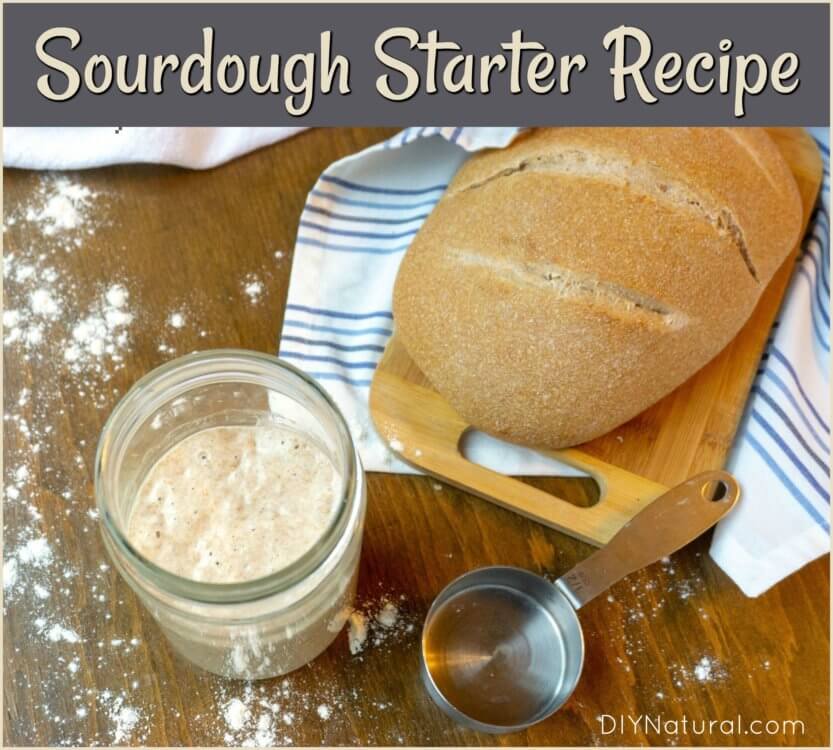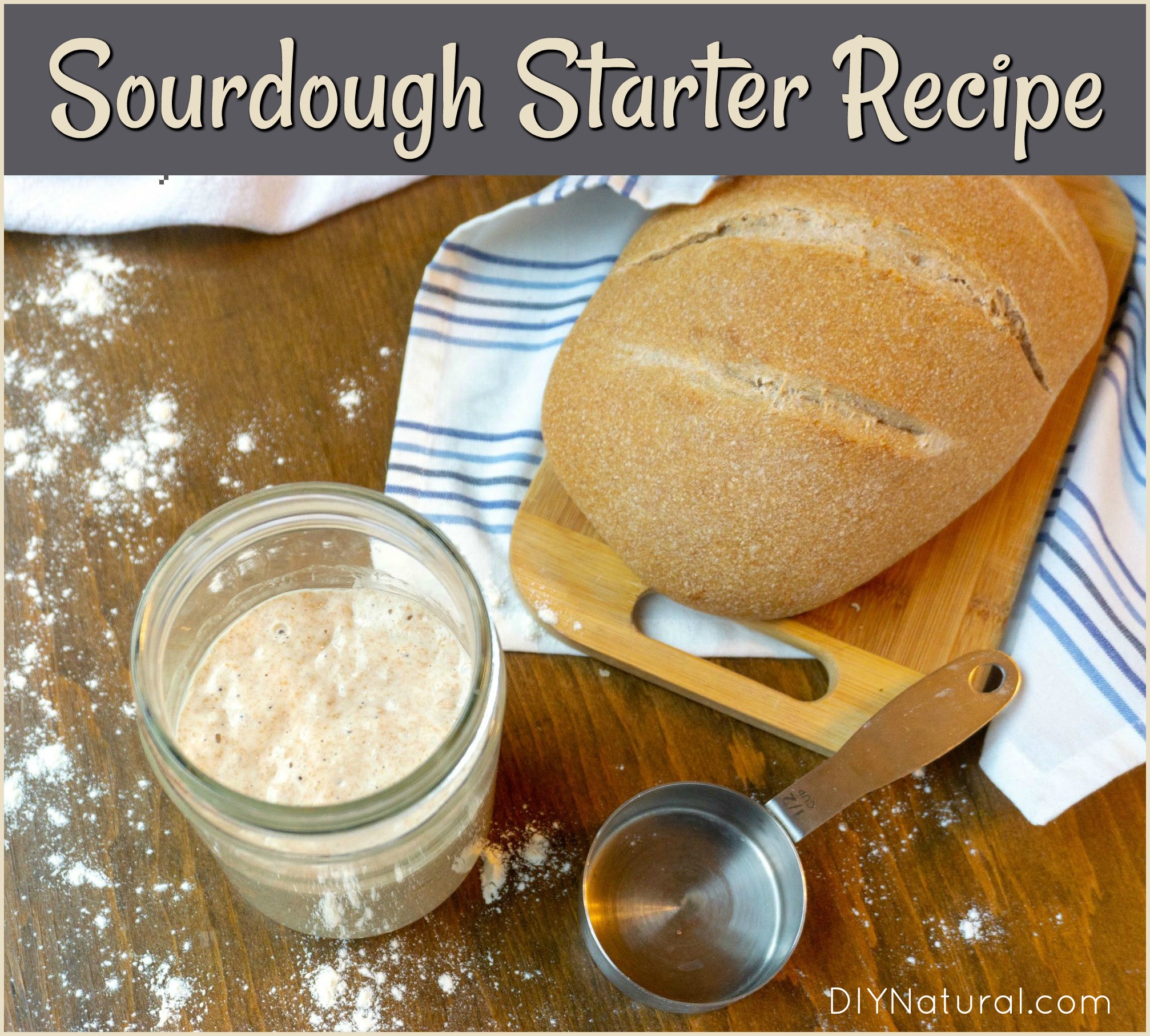
This sourdough starter recipe makes a simple, delicious, and nutritious sourdough bread every time. And once you get started it’s even easier to keep going.
Making homemade sourdough bread might seem a bit intimidating when you find out you need a starter that has to be kept on hand and fed regularly. But, once you get into a groove it’s really easy to make and keep your own sourdough starter for tasty sourdough bread!
What is Sourdough Bread?
Sourdough is an age-old process for making bread that has been used since long before commercial yeast was available.
Instead of commercial yeast, a sourdough starter recipe uses the wild yeast that is all around us. This wild yeast is captured and cultivated in a mixture of flour and water, called a starter. It is this starter which does the work to leaven your bread.
Why Sourdough Bread is Better for You
There are so many benefits to bread made from a sourdough starter recipe!
Sourdough bread is easier to digest because of the long rise time (fermentation). It doesn’t spike your blood sugar like some other breads can. And, it is also higher in some vitamins and helps your body to absorb minerals better.
The fermentation process that is needed for sourdough bread gives the dough a longer time to break down the proteins (gluten), making them easier to digest. Some people with a gluten sensitivity can actually tolerate sourdough breads!
The acids produced during the fermentation of this sourdough starter recipe don’t just create the distinct sourdough flavor, they also help keep the bread fresh longer!
One thing I really love about making sourdough bread is that I don’t have to be constantly buying jars of yeast. Once I have my starter going, it can hang out in the fridge until I need it, and I always have a leavening agent ready to make more bread.
Making a Sourdough Starter Recipe
Making sourdough starter doesn’t require any special ingredients. All you really need is:
- flour
- water
- a glass (or other non-reactive) vessel with a breathable lid (cheesecloth or a coffee filter work well)
- a non-reactive stirring utensil (a wooden spoon works great)
That’s it!
Ingredients for a Sourdough Starter Recipe
With only two ingredients, we do want to pay attention to the quality of our ingredients.
For the flour: Rye flour or whole wheat flour are higher in nutrients that help get your starter going more quickly. That’s why we feed our starter with a half and half mixture of whole wheat flour and unbleached all purpose flour. You could even start with all whole wheat (or even all rye).
After your starter is going strong, you can switch to all unbleached all-purpose, stick with whole wheat, or switch to whatever your breads require.
For the water: It is best to use filtered or distilled water, particularly if you know your water is high in chlorine, which can hinder fermentation.
Our water isn’t high in chlorine, but I have found that using our tap water to begin a fresh starter does introduce extra bacteria, which can cause it to smell a bit like cheese. Most of the time, this just means that it will take a little longer for the yeast to overpower the other bacteria, but if you find your beginning starter is taking on a smell (other than a nice, yeasty smell), try switching to distilled water to see if that helps foster just the yeast that we’re looking to cultivate.
A Basic Sourdough Starter Recipe
To make our sourdough starter we’re using a 1:1 ratio of flour and water; this ratio keeps things simple and is a good starting place. I find that 4 oz of flour and 4 oz of water creates a manageable size starter and still gives me enough to make a small loaf and have some reserve starter to hang on to.
It will take a week or more to make your starter from scratch. However, most of that time is hands-off.
Ingredients To Start (And For Each Feeding)
- 4 oz (½ cup) filtered or distilled water (find the best water filtration systems here)
- 2 oz (roughly ¼ cup + 2 Tbsp) whole wheat flour
- 2 oz (roughly ¼ cup + 2 Tbsp) unbleached all purpose flour
Instructions
- Day 1: In a 1-quart container, combine 2 oz whole wheat flour (roughly ¼ cup + 2 Tbsp) and 2 oz unbleached all purpose flour (roughly ¼ cup + 2 heaping Tbsp) with 4 oz (½ cup) water.
- Stir until well blended and cover with a lid that will let your starter breathe. (I like to use a coffee filter secured with a rubber band.)
- Leave your starter in a warm (70-85ºF) place overnight.
- Day 2-6: After 24 hours, measure out 4 oz of starter (this should be half of your starter).
- To the 4 oz of starter, add 2 oz whole wheat flour (roughly ¼ cup + 2 Tbsp), 2 oz unbleached all purpose flour (roughly ¼ cup + 2 heaping Tbsp), and 4 oz (½ cup) water.
- Stir to mix well.
- Cover with a breathable covering, and let it stand in a warm place overnight again. The starter you did not use can be discarded or used in a recipe that called for “unfed” starter. (See some ideas below!)
- Continue this feeding regimen until your starter is nice and bubbly and yeasty smelling. It should nearly double in bulk within 4 hours of feeding. (But it will fall after 6-8 hours, that’s normal.)
- Day 7 and beyond: Once your starter is bubbly and roughly doubles within 4 hours of feeding, it is ready to leaven bread!
- If you plan to make bread right away, keep feeding your starter as you have been (every 24 hours) and keep it on your counter.
- If you only need to make bread occasionally, you can store the starter in a tightly sealed container in the refrigerator and cut your feedings back to once a week.
How to Use Sourdough Starter
Always bake with a recently fed starter!
To make bread, feed your starter as you have been. Leave it out on your counter for 3-4 hours after feeding, until it is nice and bubbly, then remove what you need for your recipe.
Be sure to reserve 4 oz of starter when you take what you need for your bread! This can be tightly covered and placed back into the fridge if your next bread baking day will be over a week away. Or, it can be fed and left on the counter if you will be baking again in a day or two.
Note: If your recipe calls for more starter than you have on hand, you’ll have to prepare a few days in advance by feeding your starter without discarding any for one (or more) feedings, until you have as much as you need.
Using Sourdough Starter Discard
It can seem sad to discard sourdough starter after each feeding.
But, there are many recipes that use the “discard” or “un-fed” sourdough starter in things like pancakes, muffins, waffles, cakes, flatbreads, pizza dough, and crackers. If you can’t bear to discard starter, using it in another recipe is a great option.
Have you ever tried a sourdough starter recipe? If so, share about this in the comments below!
*******




Can I use einkorn all purpose flour as.the starter? If so, do you have an einkorn sourdough bread recipe to go with it?
Here is a recipe for einkorn sourdough bread.
https://jovialfoods.com/recipes/einkorn-sourdough-artisan-bread/
try breadtopia.com He has many wonderful recipes for sourdough bread and einkorn is one of them!
Yes, since einkorn is a type of wheat, you can use it in place of the wheat or rye in this starter recipe.
This is fantastic…thank you! I was wondering how long this will last in fridge without spoiling? What type of container is best for storing in fridge? I wonder along with Linda about flours that can be used. I can start with all rye and eventually use other flours such as spelt or coconut etc.? Very curious to get going on this.
The starter will last for months in the fridge. However, if you go more than a week or two without feeding it, you may need to do a couple of back to back feeding days to get it nice and bubbly for baking. If you leave it so long it develops a tan liquid, that’s fine, just stir it in and feed it.
Plastic or glass containers are the best for storing it. Something with a loose lid, or just leave the lid very slightly cracked.
And, yes, you can start it with rye and convert it to other flours once you get it going. I’m not sure how it would work with coconut flour. What I would do to try coconut flour would be feed it like normal (with rye or wheat) but don’t discard any. Then divide it in half. Continue feeding half of the starter the way you have been, and feed the other half with the coconut flour. This way you don’t lose your entire starter if it doesn’t respond well to the coconut flour.
I’ve tried this before with real bread flour but does it work with gluten free? My digestive system is not good and reacts badly to ordinary bread.
I think it would all depend on what type of gluten-free flour you are using. Often people who have a sensitivity to gluten can tolerate sourdough bread because the fermentation process makes it easier to digest.
Can this starter be made with Spelt flour as a wheat or Rye substitute?
Since spelt is a type of wheat, it should work just fine to replace the wheat or rye in this starter.